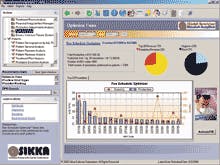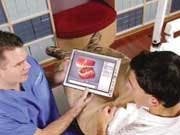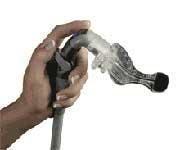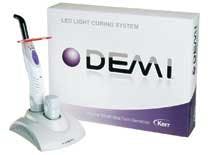Equipment and ideas for the efficient practice
For more on this topic, go to www.dentaleconomics.com and search using the following key words: equipment, ideas, efficient practice, wish list, Blaes.
In my dental experience of many years, I cannot think of a time when I wasn't wishing for another product. I would think, "If only I had this or that, my practice would be perfect and I could be more productive."I remember when my mentor told me he had bought a Panorex from SS White. The next time I was at his office, he proudly showed me the machine and the films he had taken. As someone accustomed to periapical films, I thought his films were great. Next, he showed me how he was going to pay for the Panorex in just a little more than a year simply by dropping a dollar in a jar every time he took a film. He also gave me the name of the equipment manager at the local supply house to call for my Panorex, because I could not practice dentistry without one. I called and they were back ordered. It took six months to get mine. As I recall, they only had two color choices in those days — beige and green.
I think we all may have a "wish list" for our practices. The items probably depend on how long we've been in practice and how well we keep up with new advancements. Here is my list in the order I think you should consider them.
The dentist's primary instrument
The first item on my list is something to cut teeth with. As far as I'm concerned, our most important instrument is the handpiece. I was there when the "Borden" air rotor came on the market. This was an enormous step up from the belt-driven handpiece I was using. In today's world, I recommend an electric handpiece because of the constant torque, no vibration, no high-pitch sound, and ease of use. I suggest looking at four brands: Bien Air (www.bienair.com), KaVo (www.kavo.com), Sirona (www.sirona.com) and A-dec (www.a-dec.com).
The importance of synergy
The next item is team. My practice really took off when I realized the tremendous synergy that takes place when you work with a group of people who are all pulling toward the same goal. If you have someone who is constantly negative, fire that person. I know it's hard to fire people, but it's necessary if a person drags the whole group down. Hire for attitude, not training. You can teach a person with the right attitude all about dentistry. Look for that person in unlikely places, such as other service positions, in your own practice, the great waitress at a restaurant; you will be surprised what you find. A great resource for team is a new book by Drs. Matt Bynum and Art Mowery Jr., "The Boomerang Effect for Dental Professionals." Order online at www.bynummoweryway.com or call (864) 297-5585.
Be truly painless
Now that you have a team, next is to develop a "wow" experience for your patients. The beginning of a wow experience is this: don't hurt your patients. In today's dental office, there is no excuse for causing pain. Learn empathy! Learn how to give a painless injection! Learn all the little things to make patients more comfortable during any dental procedure — things like music, headphones, warm blankets, a caring touch, a caring tone of voice, a "stop" signal for the patient, protective tinted glasses, nitrous oxide, video (Midmark has a great monitor that attaches to your track-light track at www.midmark.com), Carmex to keep the lips moist, and a luxurious moist warm towel from White Towel Services (www.whitetowelservices.com) for when you are finished. Your patients will talk about your "wow" office. You can add to this list with the help of your team.
Manage your practice efficiently
You will need practice-management software to run the business side of your practice. I would suggest using one of the big three providers. Henry Schein Companies (www.henryschein.com/us-en/dental/services/PracticeMgmt.aspx) has Dentrix® and Easy Dental® (a great starter system), Patterson Dental (www.patterson.eaglesoft.net/index.htm) has EagleSoft, and Kodak (www.kodakdental.com) has PracticeWorks and SoftDent. All of these systems do a great job of managing the business of the practice. I recently came across a great program that integrates with all of these software systems to provide an overview of the practice. This "dashboard" software is supplied by the Sikka Software company (www.sikkasoft.com). Sikka Software and Dental Economics® recently formed an alliance to help you manage your practice. For more information, go to www.dentaleconomics.com.
Interactive patient education
One of the big problems in many dental practices is trying to explain a dental problem to patients. Most systems on the market are not interactive and your patients must watch a long video that you hope will explain their problem. The Henry Schein GURU™ is an interactive computer program that allows you to go right to the part of the animation you want the patient to see. Then you can stop the animation, draw on the image, or make notes and save the image to the patient record or print it for them to take home. You can import patient images or X-rays to the GURU. This is an amazing system that must be seen to be believed. There are more than 200 great animations to explain all aspects of dentistry. Go to www.howdoyouguru.com for a look at the GURU Online Community. This is a must-have for all dental offices.
An isolated oral field is essential
We all preach about using isolation for our dental procedures, and I thought most dentists did until I heard a statistic that claimed less than 10 percent of all dentists use a rubber dam. Wow, that amazed me! We all know it is critical to control moisture during a bonding procedure and that is almost impossible with cotton rolls and an aspirator. Now there is a better way — the Isolite dryfield illuminator! With one instrument that connects to your suction and a 110v outlet, you get five settings of light directly in the mouth, total isolation of one side of the mouth, retraction of the tongue and cheek, aspiration of either the upper and lower at the same time or the upper only or the lower, a bite block to maintain opening, and completely hands-free operation. Go to www.isolite systems.com/easytool for more information on a 30-day, risk-free special offer or call (800) 560-6066. This is another must-have for every dental office.
X-rays: get digital!
To make your diagnostic radiography simple and fast, get a digital radiography system. This is great and tested technology that makes every office run smoother. There are many great companies that have digital radiography systems and it is often hard to make a decision. A regular DE® contributor, Dr. Lorne Lavine, wrote some words of wisdom a couple of years ago about choosing a system:
"All of the systems are capable of producing diagnostic images, so how does an office choose? While many vendors would recommend that you consider resolution first, there are many other factors to consider. Since the process of purchasing a digital system often requires the same amount of thought as buying a diamond, I think this makes a good analogy. Shopping for diamonds requires you to consider the 4 C's — carat, color, cut, and clarity. There are also 4 C's for choosing digital radiography: comfort, compatibility, company, and of course, cost.
Comfort
While some companies would have you believe that the thinner the sensor, the more comfortable it is, that has not been my experience. Many of the complaints from patients are with those thinner sensors. A few factors have a direct impact on comfort. The edges of the sensor are something that should be evaluated, because this is what patients tend to feel. Also, since sensors require unique positioning systems, these can have more of an effect on comfort than anything else. Almost all systems come with a RINN-style positioner, but there are other systems, such as Wingers (http://www.steri-shield.com/wingers.htm), and Sensor-Stik (http://www.dentequip.com/).
Compatibility
Many offices are already using image-management software for storing images, such as from intraoral cameras, digital cameras, or scanners. Some of these are integrated with the practice-management software, and some are free standing. It is crucial when considering digital radiography to choose an image-management program before choosing a sensor. Many dentists prefer to have all their images stored in the same software. Therefore, if an office is already using an image program, it will be limited to whatever system is compatible with that software. In a perfect world, it would be easy to switch to another imaging program, but it is rarely that easy. To do so requires conversion of the images into the new program, and this is often difficult, if not impossible. So, dentists choosing digital radiography systems will need to evaluate their software situation first.
Company
Primarily due to the growing popularity of digital radiography, there has been an explosion in the number of companies offering sensor systems — and this number is growing! While some are backed by large dental supply companies such as Kodak, Schein, and Patterson, many systems are from smaller companies with less financial resources or track records. There is nothing wrong with purchasing a system from a small company; the service and support is often excellent and their products are on par with others out there. However, some companies have gone out of business in the past few years, and dentists should understand all of the risks in buying a lesser-known product. Another good sign of a company's ability and willingness to support its products is the length of the warranty. While a few offer only one-year warranties, some vendors now offer five-year warranties. As a caveat, though, these warranties usually only cover manufacturer's defects, not damage, and should be supplemented with the office's equipment insurance policy.
Cost
Finally, cost cannot be ignored — it's typically given as the main reason why some offices do not purchase a digital system. A basic single-sensor system starts at around $5,000, and can go as high as $14,000. Phosphor-plate systems run from about $10,000 to $20,000. Often overlooked, however, is the infrastructure needed to run these systems. Besides computers in the operatories, dentists need to consider a dedicated server, monitors, monitor mounts, wireless keyboards and mice, ink jet printers, backup devices — and the list goes on. Offices need to be aware of all the anticipated costs of "going digital," keeping in mind the cost of the sensors is usually less than the hardware needed to run these systems.
By taking the time to review the different digital-radiography systems, dentists can avoid a very expensive mistake.
Get a powerful curing light!
The new cordless LED curing lights are almost as powerful as the older plasma arc systems. Most of the new-generation LED lights claim a five-second cure for a 2 mm increment of shade 3 composite. That is really fast. Be sure to get a curing light that will continue to run for a long time without stopping because of overheating. You should be able to cure eight veneers for 40 seconds each with no problem. Look for a light that has all the features you are accustomed to. Lights that I have tried and liked are the Kerr Dental Demi (www.kerrden tal.com), the Ivoclar Vivadent Bluephase 16i (www.ivoclarviva dent.us.com), the 3M ESPE Epilar Freelight 2 (www.3mespe.com), the Dentsply Caulk SmartLite IQ 2 (www.caulk.com), and the Discus Dental FLASHlite Magna (www.discusdental.com).
I hope this starts you on the path of creating your own wish list for the products you need to make your office more fun to work in and more fun to visit.
By Dr. Joe Blaes
Editor, Dental Economics®






